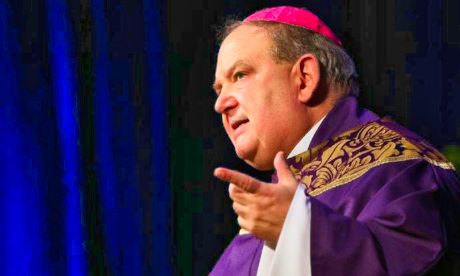When the Vatican announced new procedures to hold bishops accountable in May, the main question was: Will it work?
The legislation – called Vos Estis Lux Mundi – enacted what is known as the Metropolitan Model, in which archbishops would play a prominent role in policing those bishops in their ecclesiastical province.
This week, the first investigation into misconduct being carried out under the procedures set out in the new law was announced: Archbishop Bernard A. Hebda of St. Paul and Minneapolis (pictured) will look into allegations that Bishop Michael J. Hoeppner of Crookston “carried out acts or omissions intended to interfere with or avoid civil or canonical investigations of clerical sexual misconduct.”
In a statement on Wednesday, the archdiocese said law enforcement had also been notified of the allegations.
Jeff Anderson, a St. Paul attorney who has represented hundreds of survivors of clerical sexual abuse, told The Associated Press that the allegations against Hoeppner likely stem from lawsuits against the Crookston diocese that have been settled, including one by Ron Vasek, who was aspiring to be a deacon when, he alleged, Hoeppner blackmailed him into signing a letter in 2015 that essentially retracted his allegation that a popular priest had abused him when he was 16-years-old.
Bishop Richard Malone of Buffalo has been under fire for over a year, after his former secretary became a whistleblower.
This summer, the scandal took an almost farcical turn.
The present case would probably be held up as an example of the new legislation working as it should, with Hebda being noted as the best person to put the new law to the test.
After all, before becoming a bishop, Hebda served for over 20 years at the Vatican’s Pontifical Council for Legislative Texts, rising to become the office’s undersecretary.
When he arrived in St. Paul-Minneapolis as apostolic administrator in 2015, Hebda’s first responsibility was to clean up the mess left behind by Archbishop John Nienstedt, who was not only accused of mishandling abuse cases, but was also accused of personal sexual misconduct.
In other words, Hebda would be near the top of anyone’s list of bishops to take Vos Estis Lux Mundi for a test drive.
In fact, some cynical observers might also note that the Vatican would probably want the first few investigations to be conducted in a place like Minnesota, which is far from the intense media scrutiny likely in other parts of the United States. Like New York, for example.
However, events might make such a media intensive investigation inevitable.
Bishop Richard Malone of Buffalo has been under fire for over a year, after his former secretary became a whistleblower, and leaked hundreds of pages of diocesan records alleging that Malone had allowed accused priests to stay on the job and that he has actively engaged in abuse cover-up.
This summer, the scandal took an almost farcical turn.
Two seminarians for the diocese quit, calling on Malone to quit over his handling of clergy misconduct.
One of them, Matthew Bojanowski, alleged that he was sexually harassed by Father Jeffrey Nowak, and that Malone failed to take action when it was reported.
Later, Malone’s priest secretary — Father Ryszard Biernat – leaked secret recordings in which Malone voiced concerns that the Nowak scandal could force him to resign.
Biernat later accused the bishop of silencing him when he lodged a complaint of sexual harassment against yet another priest.
Then, in a soap opera twist, an incriminating 2016 letter began circulating. It was written by Biernat to Bojanowski, and by all appearances was romantic in nature.
Public records show the two men co-own a house.
The letter had been photographed by Nowak when he was in Bojanowski’s room. Continue reading
Related
- Mandatory reporting of clerical sexual abuse
- Analysis: ‘Vos estis’ and ‘vulnerability’
- Analysis: Is Pope Francis’ new abuse plan the answer Catholics are looking for?
